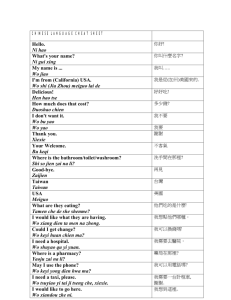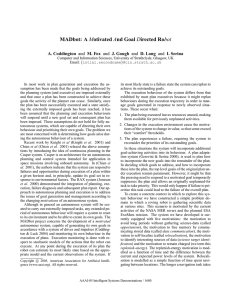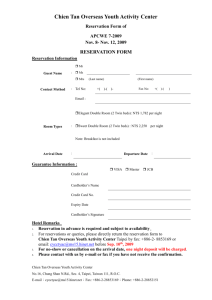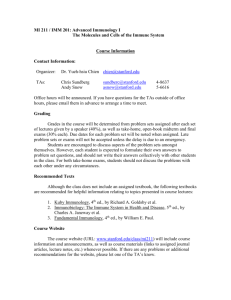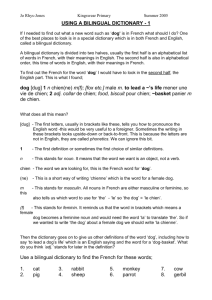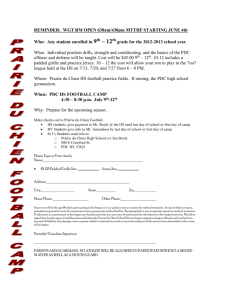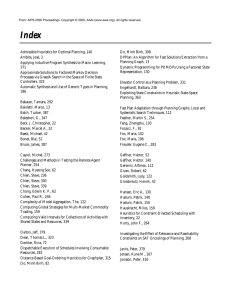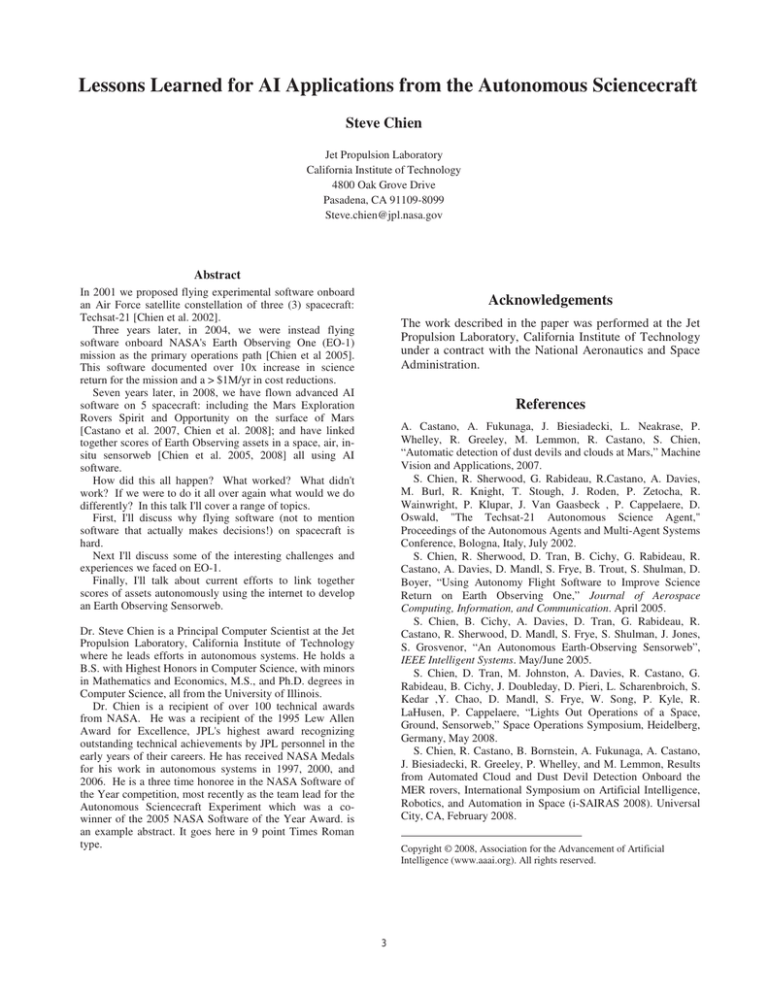
Lessons Learned for AI Applications from the Autonomous Sciencecraft
Steve Chien
Jet Propulsion Laboratory
California Institute of Technology
4800 Oak Grove Drive
Pasadena, CA 91109-8099
Steve.chien@jpl.nasa.gov
Abstract
In 2001 we proposed flying experimental software onboard
an Air Force satellite constellation of three (3) spacecraft:
Techsat-21 [Chien et al. 2002].
Three years later, in 2004, we were instead flying
software onboard NASA's Earth Observing One (EO-1)
mission as the primary operations path [Chien et al 2005].
This software documented over 10x increase in science
return for the mission and a > $1M/yr in cost reductions.
Seven years later, in 2008, we have flown advanced AI
software on 5 spacecraft: including the Mars Exploration
Rovers Spirit and Opportunity on the surface of Mars
[Castano et al. 2007, Chien et al. 2008]; and have linked
together scores of Earth Observing assets in a space, air, insitu sensorweb [Chien et al. 2005, 2008] all using AI
software.
How did this all happen? What worked? What didn't
work? If we were to do it all over again what would we do
differently? In this talk I'll cover a range of topics.
First, I'll discuss why flying software (not to mention
software that actually makes decisions!) on spacecraft is
hard.
Next I'll discuss some of the interesting challenges and
experiences we faced on EO-1.
Finally, I'll talk about current efforts to link together
scores of assets autonomously using the internet to develop
an Earth Observing Sensorweb.
Acknowledgements
The work described in the paper was performed at the Jet
Propulsion Laboratory, California Institute of Technology
under a contract with the National Aeronautics and Space
Administration.
References
A. Castano, A. Fukunaga, J. Biesiadecki, L. Neakrase, P.
Whelley, R. Greeley, M. Lemmon, R. Castano, S. Chien,
“Automatic detection of dust devils and clouds at Mars,” Machine
Vision and Applications, 2007.
S. Chien, R. Sherwood, G. Rabideau, R.Castano, A. Davies,
M. Burl, R. Knight, T. Stough, J. Roden, P. Zetocha, R.
Wainwright, P. Klupar, J. Van Gaasbeck , P. Cappelaere, D.
Oswald, "The Techsat-21 Autonomous Science Agent,"
Proceedings of the Autonomous Agents and Multi-Agent Systems
Conference, Bologna, Italy, July 2002.
S. Chien, R. Sherwood, D. Tran, B. Cichy, G. Rabideau, R.
Castano, A. Davies, D. Mandl, S. Frye, B. Trout, S. Shulman, D.
Boyer, “Using Autonomy Flight Software to Improve Science
Return on Earth Observing One,” Journal of Aerospace
Computing, Information, and Communication. April 2005.
S. Chien, B. Cichy, A. Davies, D. Tran, G. Rabideau, R.
Castano, R. Sherwood, D. Mandl, S. Frye, S. Shulman, J. Jones,
S. Grosvenor, “An Autonomous Earth-Observing Sensorweb”,
IEEE Intelligent Systems. May/June 2005.
S. Chien, D. Tran, M. Johnston, A. Davies, R. Castano, G.
Rabideau, B. Cichy, J. Doubleday, D. Pieri, L. Scharenbroich, S.
Kedar ,Y. Chao, D. Mandl, S. Frye, W. Song, P. Kyle, R.
LaHusen, P. Cappelaere, “Lights Out Operations of a Space,
Ground, Sensorweb,” Space Operations Symposium, Heidelberg,
Germany, May 2008.
S. Chien, R. Castano, B. Bornstein, A. Fukunaga, A. Castano,
J. Biesiadecki, R. Greeley, P. Whelley, and M. Lemmon, Results
from Automated Cloud and Dust Devil Detection Onboard the
MER rovers, International Symposium on Artificial Intelligence,
Robotics, and Automation in Space (i-SAIRAS 2008). Universal
City, CA, February 2008.
Dr. Steve Chien is a Principal Computer Scientist at the Jet
Propulsion Laboratory, California Institute of Technology
where he leads efforts in autonomous systems. He holds a
B.S. with Highest Honors in Computer Science, with minors
in Mathematics and Economics, M.S., and Ph.D. degrees in
Computer Science, all from the University of Illinois.
Dr. Chien is a recipient of over 100 technical awards
from NASA. He was a recipient of the 1995 Lew Allen
Award for Excellence, JPL's highest award recognizing
outstanding technical achievements by JPL personnel in the
early years of their careers. He has received NASA Medals
for his work in autonomous systems in 1997, 2000, and
2006. He is a three time honoree in the NASA Software of
the Year competition, most recently as the team lead for the
Autonomous Sciencecraft Experiment which was a cowinner of the 2005 NASA Software of the Year Award. is
an example abstract. It goes here in 9 point Times Roman
type.
Copyright © 2008, Association for the Advancement of Artificial
Intelligence (www.aaai.org). All rights reserved.
3


